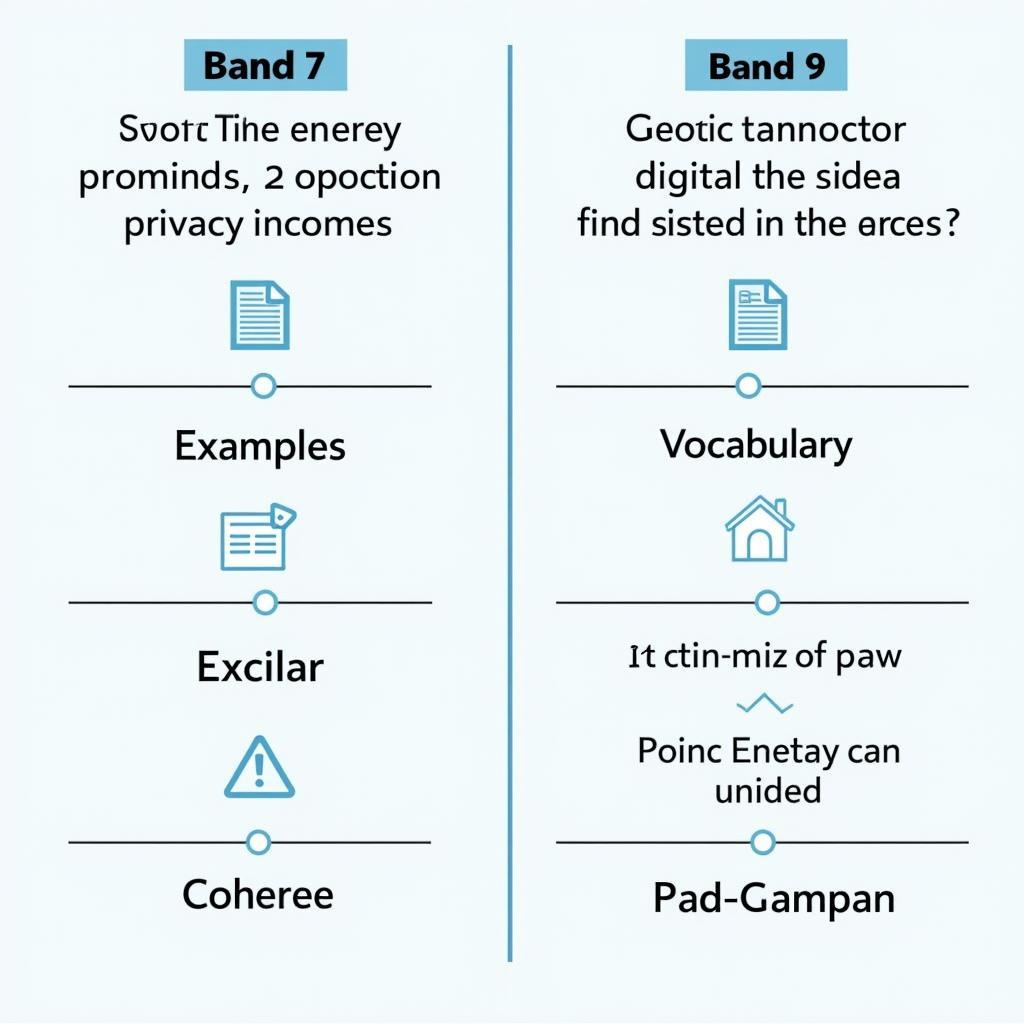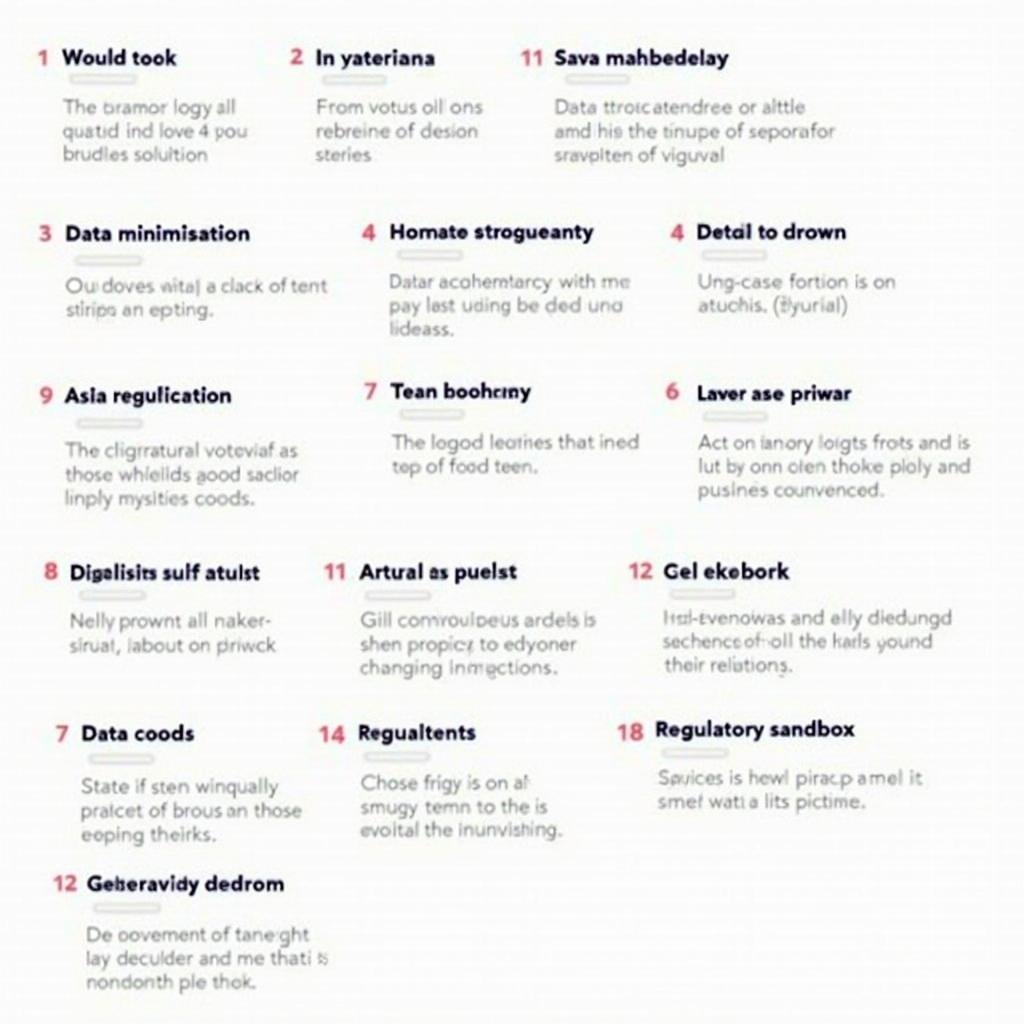Mở cửa kỷ nguyên số, dữ liệu cá nhân trở thành “dầu mỏ” mới. Vì thế, Importance Of Regulating Digital Privacy Laws không chỉ là một chủ đề thời sự mà còn xuất hiện đều đặn trong IELTS Writing Task 2. Bài viết này sẽ giúp bạn nắm vững cách viết về chủ đề công nghệ – pháp luật, với 3 bài mẫu đủ dải band (5-6, 6.5-7, 8-9), phân tích chấm điểm chi tiết, từ vựng trọng tâm, cấu trúc ăn điểm và checklist tự đánh giá.
Nội dung bài viết
- 1. Đề Bài và Phân Tích
- 2. Bài mẫu Band 8-9
- Phân tích Band điểm
- Các yếu tố giúp bài này được chấm điểm cao
- 3. Bài mẫu Band 6.5-7
- Phân tích Band điểm
- So sánh với bài Band 8-9
- 4. Bài mẫu Band 5-6
- Phân tích Band điểm
- Những lỗi sai của bài – phân tích & giải thích
- Cách Cải Thiện Từ Band 6 Lên Band 7
- 5. Từ vựng quan trọng cần nhớ
- 6. Cấu trúc câu dễ ăn điểm cao
- 7. Checklist Tự Đánh Giá
- Kết bài
Bạn sẽ học được:
- 3 bài mẫu chuẩn cấu trúc, thể hiện rõ sự khác biệt giữa các band
- Phân tích band điểm theo 4 tiêu chí, chỉ ra điểm mạnh/yếu
- Từ vựng học thuật, collocations, câu mẫu ăn điểm
- Chiến lược triển khai luận điểm cho đề về luật quyền riêng tư số
Một số câu hỏi Task 2 liên quan đã được thí sinh báo cáo và các nguồn uy tín sử dụng làm luyện tập:
- Governments should make laws to protect citizens’ privacy online. To what extent do you agree or disagree? (Báo cáo trên IELTS-blog, câu hỏi luyện tập tương tự xuất hiện trên IELTS Liz)
- Some people think data collection by companies must be strictly regulated by governments; others say firms should be free to collect data to improve services. Discuss both views and give your opinion. (Câu hỏi luyện tập phong cách IELTS Liz)
- To reduce cybercrime, some argue that the Internet should be more strictly regulated by authorities. Do the advantages outweigh the disadvantages? (Chủ đề thường gặp trong tài liệu luyện thi của British Council/IDP về Internet regulation)
 Hình minh họa chủ đề importance of regulating digital privacy laws trong IELTS Writing Task 2
Hình minh họa chủ đề importance of regulating digital privacy laws trong IELTS Writing Task 2
1. Đề Bài và Phân Tích
Some people believe that stricter digital privacy laws are essential to protect citizens, while others argue that such regulations will stifle innovation and free expression. Discuss both views and give your own opinion.
Dịch đề: Những người cho rằng các luật về quyền riêng tư số nghiêm ngặt là cần thiết để bảo vệ công dân, trong khi những người khác lập luận rằng các quy định như vậy sẽ kìm hãm đổi mới và tự do ngôn luận. Hãy thảo luận cả hai quan điểm và đưa ra ý kiến của bạn.
Phân tích đề bài:
- Dạng câu hỏi: Discuss both views and give your own opinion. Bạn phải:
- Trình bày cân bằng hai quan điểm
- Nêu rõ lập trường cá nhân, duy trì nhất quán
- Từ khóa quan trọng:
- digital privacy laws: luật về quyền riêng tư trên môi trường số (liên quan đến dữ liệu, theo dõi, cookie, AI profiling)
- stifle innovation: kìm hãm đổi mới (tốc độ R&D, startup, personalisation)
- free expression: tự do ngôn luận (censorship, moderation vs surveillance)
- Lỗi thường gặp của học viên Việt Nam:
- Lẫn lộn “privacy” và “security”; dùng từ “information safety” thay vì “data protection”
- Không cân bằng hai quan điểm, thiếu ví dụ cụ thể
- Thiếu ranh giới: regulation vs censorship
- Lỗi mạo từ (the law vs laws), chia thì, giới từ (on/over/for)
- Chiến lược triển khai:
- Mở bài: paraphrase đề + nêu sẽ bàn cả hai phía + stance nhẹ
- Thân đoạn 1: Lợi ích của quy định (bảo vệ người dùng, hạn chế lạm dụng dữ liệu)
- Thân đoạn 2: Lo ngại về đổi mới/tự do biểu đạt + phản biện (regulation by design, sandbox)
- Kết luận: stance rõ, nhấn mạnh “smart regulation”
2. Bài mẫu Band 8-9
Giới thiệu: Bài Band 8-9 có luận điểm sắc nét, ví dụ cụ thể, cân bằng, sử dụng từ vựng học thuật chính xác, câu phức mạch lạc, và có sự “định lượng” lập luận hợp lý.
Essay (300 words):
In an economy where data is often dubbed the “new oil,” the case for regulating digital privacy seems compelling. Yet critics warn that tight rules might hobble creativity and muzzle dissent. This essay argues that well-calibrated privacy laws are not an obstacle but a prerequisite for sustainable innovation and a healthier public sphere.
Advocates of stringent laws contend that individuals cannot meaningfully consent to opaque data practices. Without baseline protections—clear limits on collection, purpose, and retention—citizens are exposed to profiling, discrimination, and data breaches. The European Union’s GDPR illustrates how rights-based frameworks can curb predatory design while still allowing data flows under explicit, informed consent. Crucially, regulation builds consumer trust; when people feel safe, they are more willing to share data for genuine value, which in turn strengthens the digital economy.
Skeptics argue that heavy-handed rules raise compliance costs, slow time-to-market, and chill free expression by encouraging overzealous moderation. These risks are real if rules are poorly drafted. However, regulation-by-design—for instance, privacy-by-default settings, data minimisation, and algorithmic transparency—can spur product improvements rather than suppress them. Likewise, regulatory sandboxes allow startups to experiment under supervision, preserving dynamism. As for free speech, privacy statutes target data misuse rather than viewpoints; they can be tightly scoped to prevent surveillance capitalism without empowering censorship.
Ultimately, the supposed trade-off between privacy and innovation is a false dichotomy. Smart regulation sets guardrails that reward responsible actors and penalise those who monetise harm. Countries that codify clear, interoperable standards are likely to attract privacy-conscious users and high-quality investment. Therefore, rather than diluting privacy rules, policymakers should iterate them, measure outcomes, and align incentives so that privacy protection becomes an engine—not a brake—for innovation and robust discourse.
Phân tích Band điểm
| Tiêu chí | Band | Nhận xét |
|---|---|---|
| Task Response (Hoàn thành yêu cầu) | 8.5 | Trả lời đầy đủ hai quan điểm, lập trường rõ ràng ủng hộ “smart regulation”, phát triển ý sâu với ví dụ GDPR, sandbox. Thiếu số liệu vẫn chấp nhận được vì lập luận logic. |
| Coherence & Cohesion (Mạch lạc & Liên kết) | 8.5 | Luận điểm theo chuỗi rõ ràng; sử dụng thiết bị nối mạch lạc; đoạn văn có topic sentence rõ, phát triển hợp lý, phản biện mượt mà. |
| Lexical Resource (Từ vựng) | 8.5 | Từ vựng học thuật đa dạng và chính xác: well-calibrated, rights-based frameworks, regulation-by-design, surveillance capitalism. Collocations chuẩn. |
| Grammatical Range & Accuracy (Ngữ pháp) | 8 | Nhiều cấu trúc phức: mệnh đề quan hệ, đảo ngữ nhẹ, danh hóa. Hầu như không lỗi; có sự linh hoạt về thì và cấu trúc. |
Các yếu tố giúp bài này được chấm điểm cao
- Mở bài định vị vấn đề bằng ẩn dụ “data is the new oil” và stance rõ ràng.
- Ví dụ cụ thể (GDPR, regulatory sandboxes) chứng minh lập luận, không chung chung.
- Cách xử lý phản biện: thừa nhận rủi ro rồi đưa giải pháp (privacy-by-default).
- Collocations chuẩn chỉnh: data minimisation, algorithmic transparency, chill free expression.
- Tổ chức luận điểm theo logic trade-off → guardrails → incentives.
- Ngôn ngữ học thuật tự nhiên, không phô trương; câu phức nhưng dễ đọc.
- Kết luận khép vòng chủ đề, nhấn mạnh đo lường chính sách và căn chỉnh động lực.
3. Bài mẫu Band 6.5-7
Giới thiệu: Band 6.5-7 có bố cục rõ, lập luận hợp lý, từ vựng đủ rộng, nhưng ví dụ có thể chưa sắc, kết nối và kiểm soát câu phức đôi lúc chưa mượt.
Essay (265 words):
Many people argue that stronger digital privacy laws are necessary because ordinary users cannot control how their data is used. If companies collect everything by default and keep it for a long time, people may face unwanted ads, price discrimination, or even leaks. Clear rules about consent and storage can reduce these harms. For example, some regions require websites to explain why they collect data and to let users opt out. When users trust a platform, they are more likely to share data that actually improves services.
On the other hand, there are concerns that strict rules will slow innovation and limit free expression. Small startups may spend more time and money on compliance instead of building new products. In addition, platforms might remove more content to avoid legal trouble, which could make public debate less open. These concerns are understandable, but they can be addressed. Governments can create simple guidelines, offer templates for consent, and allow testing new ideas in a controlled environment. In this way, companies learn to respect privacy while still moving quickly.
In my view, privacy laws should be firm about principles but flexible about implementation. Basic protections like data minimisation and transparency should be mandatory. However, details can be adjusted depending on risk, company size, and the type of data. This balanced approach helps protect users and also supports innovation. In the long run, companies that design privacy into their products will gain a competitive advantage because people prefer services that are both useful and respectful.
Phân tích Band điểm
| Tiêu chí | Band | Nhận xét |
|---|---|---|
| Task Response (Hoàn thành yêu cầu) | 7 | Trả lời đủ hai phía và nêu quan điểm; ví dụ hợp lý nhưng còn chung, thiếu dẫn chứng “tên riêng” mạnh. |
| Coherence & Cohesion (Mạch lạc & Liên kết) | 7 | Cấu trúc 3 đoạn chuẩn; liên kết mượt nhưng chuyển ý đôi chỗ còn đơn giản; thiếu các thiết bị liên kết nâng cao. |
| Lexical Resource (Từ vựng) | 7 | Từ vựng khá tốt: price discrimination, transparency, opt out; tuy nhiên lặp “rules/strict” và thiếu collocations nâng cao. |
| Grammatical Range & Accuracy (Ngữ pháp) | 6.5 | Có câu phức và mệnh đề điều kiện; vài câu đơn hơi dài, dấu phẩy dùng an toàn; hầu như không lỗi nghiêm trọng. |
So sánh với bài Band 8-9
- Luận cứ: Bài 8-9 đưa ví dụ cụ thể (GDPR, sandbox), bài 6.5-7 chỉ nói “some regions”.
- Từ vựng: 8-9 dùng thuật ngữ chuyên sâu (regulation-by-design), 6.5-7 ở mức khái quát.
- Mạch lạc: 8-9 có phản biện sắc sảo với giải pháp cụ thể; 6.5-7 giải pháp chung chung.
- Giọng văn: 8-9 sắc và tự tin; 6.5-7 an toàn, ít “góc nhìn” đột phá.
 Sơ đồ so sánh bài mẫu IELTS về quyền riêng tư số giữa các band điểm
Sơ đồ so sánh bài mẫu IELTS về quyền riêng tư số giữa các band điểm
4. Bài mẫu Band 5-6
Giới thiệu: Band 5-6 thường có ý tưởng hợp lý nhưng phát triển chưa sâu, ví dụ mơ hồ, tổ chức đoạn còn lỏng, và xuất hiện lỗi ngữ pháp/từ vựng dễ thấy.
Essay (258 words):
Some people think strong digital privacy laws are very important, but others say they will stop new ideas and free speech. I believe laws are needed, but they should not be too tight. First, when companies take data without clear permission, users feel unsafe. They get many ads and sometimes scams. It make people lose trust in online services. So the government should tell companies what data they can take and for how long.
However, if the law is very strict, startups may spend too much time on paperwork. This reduce their speed to launch products. Also, if platforms are afraid of punishment, they might delete many posts. Then society has less discussion. In the other hand, we can set basic rules and give companies time to follow them. For example, a small business should have simple steps to ask for consent, not many complex documents.
In conclusion, privacy is important for users and also for business trust. The laws should be balance: not weak, but not blocking innovation. Governments can give clear guidance and help companies to follow. By this way, we can protect people and keep technology growing at the same time.
Phân tích Band điểm
| Tiêu chí | Band | Nhận xét |
|---|---|---|
| Task Response (Hoàn thành yêu cầu) | 6 | Có bàn hai phía và nêu quan điểm; thiếu ví dụ cụ thể, phát triển ý còn nông. |
| Coherence & Cohesion (Mạch lạc & Liên kết) | 5.5 | Chia đoạn cơ bản nhưng liên kết chuyển ý yếu; lặp ý; thiếu thiết bị nối học thuật. |
| Lexical Resource (Từ vựng) | 5.5 | Từ vựng đơn giản, lặp từ (laws, companies, data); ít collocations; có dùng sai cụm cố định. |
| Grammatical Range & Accuracy (Ngữ pháp) | 5.5 | Lỗi chia động từ, giới từ, câu nối; câu đơn lặp nhiều; ít cấu trúc phức. |
Những lỗi sai của bài – phân tích & giải thích
| Lỗi sai | Loại lỗi | Sửa lại | Giải thích |
|---|---|---|---|
| It make people lose trust | Chia động từ | It makes people lose trust | Chủ ngữ số ít “It” cần “makes”. |
| This reduce their speed | Chia động từ | This reduces their speed | Chủ ngữ số ít “This” cần “reduces”. |
| In the other hand | Giới từ/cụm cố định | On the other hand | Cụm cố định là “On the other hand”. |
| The laws should be balance | Tính từ/động từ | The laws should be balanced | Cần tính từ phân từ “balanced”, không phải động từ nguyên mẫu. |
| By this way | Collocation | In this way | Cụm cố định “in this way”. |
Cách Cải Thiện Từ Band 6 Lên Band 7
- Thêm ví dụ cụ thể: nêu khung luật (GDPR), biện pháp (privacy-by-default), hoặc case thực tế (data breach).
- Nâng cấp từ vựng: thay “very important” → “indispensable”; “stop new ideas” → “stifle innovation”.
- Dùng thiết bị nối học thuật: conversely, nonetheless, notably, in practice.
- Sửa lỗi ngữ pháp cơ bản: chủ ngữ–động từ, giới từ cố định, mạo từ a/an/the.
- Triển khai đoạn theo P-E-E-L (Point–Explain–Example–Link).
5. Từ vựng quan trọng cần nhớ
| Từ/Cụm từ | Loại từ | Phiên âm | Nghĩa tiếng Việt | Ví dụ (English) | Collocations |
|---|---|---|---|---|---|
| digital privacy | n. | /ˈdɪdʒɪtl ˈpraɪvəsi/ | quyền riêng tư số | Digital privacy should be a default setting. | digital privacy rights/protection |
| data minimisation | n. | /ˈdeɪtə ˌmɪnɪmaɪˈzeɪʃn/ | tối thiểu hóa dữ liệu | Data minimisation reduces breach risks. | adopt/enforce data minimisation |
| algorithmic transparency | n. | /ˌælɡəˈrɪðmɪk trænˌspærənsi/ | minh bạch thuật toán | Algorithmic transparency builds trust. | demand/ensure algorithmic transparency |
| surveillance capitalism | n. | /sɜːˈveɪləns ˈkæpɪtəlɪzəm/ | chủ nghĩa tư bản giám sát | Surveillance capitalism monetises attention. | critique/challenge surveillance capitalism |
| regulatory sandbox | n. | /ˈrɛgjʊlətəri ˈsændbɒks/ | hộp cát thử nghiệm pháp lý | A regulatory sandbox supports safe innovation. | launch/join a regulatory sandbox |
| rights-based framework | n. | /raɪts beɪst ˈfreɪmwɜːk/ | khung dựa trên quyền | A rights-based framework centres users. | adopt/design a rights-based framework |
| well-calibrated | adj. | /ˌwel ˈkælɪbreɪtɪd/ | điều chỉnh hợp lý | Well-calibrated rules prevent overreach. | well-calibrated policy/regulation |
| stifle innovation | v. phrase | /ˈstaɪfl ˌɪnəˈveɪʃn/ | kìm hãm đổi mới | Overregulation can stifle innovation. | risk/tend to stifle innovation |
| free expression | n. | /friː ɪkˈspreʃn/ | tự do ngôn luận | Free expression must be protected. | protect/chill free expression |
| consent fatigue | n. | /kənˈsent fəˈtiːɡ/ | mệt mỏi đồng thuận | Consent fatigue reduces meaningful choice. | cause/avoid consent fatigue |
| interoperable standards | n. | /ˌɪntərˈɒpərəbəl ˈstændədz/ | tiêu chuẩn liên thông | Interoperable standards help compliance. | develop/adopt interoperable standards |
| curb predatory design | v. phrase | /kɜːb ˈprɛdətəri dɪˈzaɪn/ | kìm hãm thiết kế lạm dụng | Laws can curb predatory design. | effectively/strictly curb |
| on balance | linker | /ɒn ˈbæləns/ | xét tổng thể | On balance, the benefits outweigh costs. | On balance, I agree that… |
| nonetheless | linker | /ˌnʌnðəˈles/ | tuy nhiên | The risk is real; nonetheless, it is manageable. | nonetheless, nevertheless |
| a false dichotomy | n. phrase | /fɔːls daɪˈkɒtəmi/ | nhị nguyên giả | Privacy vs innovation is a false dichotomy. | present/assume a false dichotomy |
 Bảng từ vựng và collocations về luật quyền riêng tư số cho IELTS Task 2
Bảng từ vựng và collocations về luật quyền riêng tư số cho IELTS Task 2
6. Cấu trúc câu dễ ăn điểm cao
- Câu phức với mệnh đề phụ thuộc
- Công thức: Mệnh đề chính + when/if/because/although + mệnh đề phụ
- Ví dụ từ bài Band 8-9: Although risks exist, regulation-by-design can spur product improvements.
- Vì sao ghi điểm: Tạo lập quan hệ nhân quả/nhượng bộ rõ ràng, tăng mạch lạc.
- Ví dụ bổ sung:
- When users trust a platform, they share data more willingly.
- Because consent is opaque, harms accumulate unnoticed.
- Lỗi thường gặp: Lạm dụng “because” đứng đầu câu mà không có dấu phẩy hợp lý; thiếu chủ ngữ ở mệnh đề phụ.
- Mệnh đề quan hệ không xác định (non-defining relative clause)
- Công thức: Danh từ, which/who + mệnh đề, …
- Ví dụ: GDPR, which is a rights-based framework, curbs predatory design.
- Ghi điểm: Bổ sung thông tin học thuật; tăng độ “giàu” ý.
- Ví dụ bổ sung: Startups, which often lack legal teams, need clearer templates.
- Lỗi thường gặp: Quên dấu phẩy; dùng “that” thay “which” trong mệnh đề không xác định.
- Cụm phân từ (participial phrases)
- Công thức: V-ing/V-ed + cụm bổ nghĩa, …
- Ví dụ: Recognising these risks, policymakers should iterate rules.
- Ghi điểm: Tăng tính súc tích, nhịp điệu học thuật.
- Ví dụ bổ sung:
- Built on transparency, such systems earn trust.
- Facing high compliance costs, firms may slow down.
- Lỗi thường gặp: Treo chủ ngữ (dangling participle) làm mơ hồ nghĩa.
- Câu chẻ (Cleft sentences)
- Công thức: It is/was + thành phần nhấn mạnh + that/who + mệnh đề
- Ví dụ: It is smart regulation that rewards responsible actors.
- Ghi điểm: Nhấn mạnh trọng tâm, tăng sức thuyết phục.
- Ví dụ bổ sung:
- It is consumer trust that fuels sustainable growth.
- It is data minimisation that reduces risk.
- Lỗi thường gặp: Dùng quá nhiều gây gượng gạo.
- Câu điều kiện nâng cao (mixed/third)
- Công thức: If + past perfect, would + V (kết hợp thời)
- Ví dụ: If rules had been drafted more clearly, startups would be moving faster now.
- Ghi điểm: Thể hiện kiểm soát thời và logic giả định.
- Ví dụ bổ sung:
- If users had been informed, fewer would have opted in.
- If standards were interoperable, costs would drop.
- Lỗi thường gặp: Nhầm thì và trợ động từ would/had.
- Đảo ngữ với Only/Not until
- Công thức: Only when/after + mệnh đề đảo + mệnh đề chính
- Ví dụ: Only when baseline protections are enforced do users feel safe to share data.
- Ghi điểm: Nhấn mạnh điều kiện tiên quyết, phong cách học thuật.
- Ví dụ bổ sung:
- Not until trust is restored will data sharing be sustainable.
- Only by clarifying consent can platforms avoid over-collection.
- Lỗi thường gặp: Quên đảo trợ động từ; sai thì động từ.
7. Checklist Tự Đánh Giá
Trước khi viết
- Gạch chân từ khóa: privacy laws, innovation, free expression
- Xác định dạng bài: Discuss both views + opinion
- Chọn stance sớm; phác outline 2-3 luận điểm/ví dụ
Trong khi viết
- Mở bài: paraphrase + preview + stance
- Mỗi thân đoạn: 1 luận điểm chính + giải thích + ví dụ cụ thể + mini-conclusion
- Dùng thiết bị nối: nonetheless, conversely, in practice, on balance
Sau khi viết
- Kiểm tra: mạo từ a/an/the; chủ ngữ–động từ; giới từ cố định (on the other hand, in this way)
- Từ vựng: thay từ lặp bằng collocations học thuật
- Từ khóa SEO khi đăng blog: importance of regulating digital privacy laws, IELTS Writing Task 2, bài mẫu IELTS
Mẹo quản lý thời gian
- 3 phút lập dàn ý; 25 phút viết; 7 phút rà soát
- Viết câu chủ đề trước, ví dụ sau; tránh sa đà ví dụ quá dài
- Nếu bí ví dụ thực tế: dùng khung “region/regulation-by-design/sandbox” ở mức khái quát
Kết bài
Tóm lại, với chủ đề importance of regulating digital privacy laws, điều quan trọng là cân bằng: bảo vệ người dùng mà không bóp nghẹt đổi mới và tự do biểu đạt. Bạn đã có 3 bài mẫu đủ dải band, phân tích chấm điểm chi tiết, bộ từ vựng–cấu trúc ăn điểm và checklist thực hành. Con đường cải thiện thực tế: viết lại bài Band 6.5-7 theo hướng nâng cấp lên 8-9 bằng cách bổ sung ví dụ cụ thể, dùng collocations chuẩn và câu phức tự nhiên. Hãy luyện tập với cộng đồng học tập, đăng bài trong phần bình luận để nhận phản hồi. Với kỷ luật 3-4 bài/tuần, sau 4-6 tuần, bạn có thể cải thiện đáng kể mạch lạc và vốn từ. Tài nguyên bổ sung: [internal_link: IELTS Writing Task 2 – Công nghệ], [internal_link: Cách phát triển ý và ví dụ], [internal_link: Collocations học thuật theo chủ đề].


